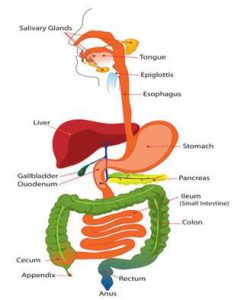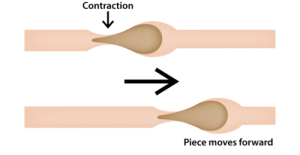
Digestive System
Introduction
- The respiratory and circulatory systems work together to provide cells with the oxygen they need for cellular respiration.
- Cells also need glucose for cellular respiration. Glucose is a simple sugar that comes from the food we eat.
- To get glucose from food, digestion must occur. This process is carried out by the digestive system.
Overview of the Digestive System
- The digestive system consists of organs that break down food and absorb nutrients such as glucose.
- Organs of the digestive system are shown in Figure below. Most of the organs make up the gastrointestinal tract. The rest of the organs are called accessory organs
The Gastrointestinal Tract
- The gastrointestinal (GI) tract is a long tube that connects the mouth with the anus. It is more than 9 meters (30 feet) long in adults and includes the esophagus, stomach, and small and large intestines.
- Food enters the mouth, passes through the other organs of the GI tract, and then leaves the body through the anus.
- The organs of the GI tract are lined with mucous membranes that secrete digestive enzymes and absorb nutrients.
- The organs are also covered by layers of muscle that enable peristalsis.
- Peristalsis is an involuntary muscle contraction that moves rapidly along an organ like a wave (see Figure below).
Accessory Organs of Digestion
- Other organs involved in digestion include the liver, gall bladder, and pancreas.
- They are called accessory organs because food does not pass through them. Instead, they secrete or store substances needed for digestion.
Functions of the Digestive System
- The digestive system has three main functions: digestion of food, absorption of nutrients, and elimination of solid food waste. Digestion is the process of breaking down food into components the body can absorb.
- It consists of two types of processes: mechanical digestion and chemical digestion.
- Mechanical digestion is the physical breakdown of chunks of food into smaller pieces. This type of digestion takes place mainly in the mouth and stomach.
- Chemical digestion is the chemical breakdown of large, complex food molecules into smaller, simpler nutrient molecules that can be absorbed by the blood. This type of digestion begins in the mouth and stomach but occurs mainly in the small intestine.
- After food is digested, the resulting nutrients are absorbed. Absorption is the process in which substances pass into the bloodstream, where they can circulate throughout the body.
- Absorption of nutrients occurs mainly in the small intestine. Any remaining matter from food that cannot be digested and absorbed passes into the large intestine as waste. The waste later passes out of the body through the anus in the process of elimination.
The Start of Digestion: Mouth to Stomach
Mouth
- The mouth is the first digestive organ that food enters. The sight, smell, or taste of food stimulates the release of digestive enzymes by salivary glands inside the mouth.
- The major salivary enzyme is amylase. It begins the chemical digestion of carbohydrates by breaking down starch into sugar.
- The mouth also begins the process of mechanical digestion. Sharp teeth in the front of the mouth cut or tear food when you bite into it. Broad teeth in the back of the mouth grind food when you chew.
- Food is easier to chew because it is moistened by saliva from the salivary glands. The tongue helps mix the food with saliva and also helps you swallow. After you swallow, the chewed food passes into the pharynx
Esophagus
- From the pharynx, the food moves into the esophagus. The esophagus is a long, narrow tube that passes food from the pharynx to the stomach by peristalsis.
- The esophagus has no other digestive functions. At the end of the esophagus, a muscle called a sphincter controls the entrance to the stomach.
- The sphincter opens to let food into the stomach and then closes again to prevent food from passing back into the esophagus.
Stomach
- The stomach is a sac-like organ in which food is further digested both mechanically and chemically.
- Churning movements of the stomach’s thick, muscular walls complete the mechanical breakdown of food.
- The churning movements also mix food with digestive fluids secreted by the stomach. One of these fluids is hydrochloric acid.
- It kills bacteria in food and gives the stomach the low pH needed by digestive enzymes that work in the stomach. The main enzyme is pepsin, which chemically digests protein.
- The stomach stores the partly digested food until the small intestine is ready to receive it. When the small intestine is empty, a sphincter opens to allow the partially digested food to enter the small intestine.
Digestion and Absorption: The Small Intestine
- The small intestine is a narrow tube about 7 meters (23 feet) long in adults. It is the site of most chemical digestion and virtually all absorption.
- The small intestine consists of three parts: the duodenum, jejunum, and ileum
Digestion in the Small Intestine
- The duodenum is the first and shortest part of the small intestine.
- Most chemical digestion takes place here, and many digestive enzymes are active in the duodenum (see Table below). Some are produced by the duodenum itself.
- Others are produced by the pancreas and secreted into the duodenum.
| Enzyme | What It Digests | Where It Is Made |
| Amylase | Carbohydrates | pancreas |
| Trypsin | Proteins | pancreas |
| Lipase | Lipids | pancreas, duodenum |
| Maltase | Carbohydrates | duodenum |
| Peptidase | Proteins | duodenum |
- The liveris an organ of both digestion and excretion. It produces a fluid called bile, which is secreted into the duodenum. Some bile also goes to the gall bladder, a sac-like organ that stores and concentrates bile and then secretes it into the small intestine.
- In the duodenum, bile breaks up large globules of lipids into smaller globules that are easier for enzymes to break down. Bile also reduces the acidity of food entering from the highly acidic stomach.
- This is important because digestive enzymes that work in the duodenum need a neutral environment. The pancreas contributes to the neutral environment by secreting bicarbonate, a basic substance that neutralizes acid.
Absorption in the Small Intestine
- The jejunum is the second part of the small intestine, where most nutrients are absorbed into the blood. The mucous membrane lining the jejunum is covered with millions of microscopic, fingerlike projections called villi (singular, villus).
- Villi contain many capillaries, and nutrients pass from the villi into the bloodstream through the capillaries. Because there are so many villi, they greatly increase the surface area for absorption.
- The ileum is the third part of the small intestine. A few remaining nutrients are absorbed here. Like the jejunum, the inner surface of the ileum is covered with villi that increase the surface area for absorption.
The Large Intestine and Its Functions
- From the small intestine, any remaining food wastes pass into the large intestine.
- The large intestine is a relatively wide tube that connects the small intestine with the anus.
- Like the small intestine, the large intestine also consists of three parts: the cecum (or caecum), colon, and rectum.

